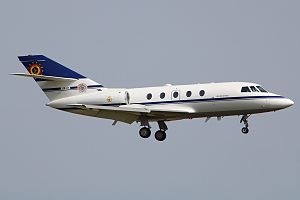Dassault HU-25 Guardian
| Falcon 20 (Mystère 20) HU-25 Guardian |
|
|---|---|
 |
|
| A Dassault Falcon 20E of the Belgium Air Force | |
| Role | Business jet |
| Manufacturer | Dassault Aviation |
| First flight | 4 May 1963 |
| Introduction | 3 June 1965 |
| Status | Out of production, in active service |
| Primary users |
Federal Express French Navy United States Coast Guard Cobham Aviation |
| Produced | 1963–1988 |
| Number built | 508 |
| Unit cost |
US$2.5M (1972)
|
| Variants |
Dassault Falcon 10 Dassault Falcon 50 |
The Dassault Falcon 20 is a French business jet developed and manufactured by Dassault Aviation. The first business jet developed by the firm, it became the first of a family of business jets to be produced under the same name; of these, both the smaller Falcon 10 and the larger trijet Falcon 50 were direct derivatives of the Falcon 20.
Initially known as the Dassault-Breguet Mystère 20, approval to proceed with development of the aircraft was issued during December 1961. On 4 May 1963, the prototype, a low-wing monoplane design, powered by a pair of rear-mounted General Electric CF700 turbojet engines, performed its maiden flight; the first production aircraft was introduced on 3 June 1965. On 10 June 1965, French aviator Jacqueline Auriol achieved the women's world speed record using the first prototype. As a result of an early distributor arrangement with American airline Pan American, American-delivered aircraft were marketed under the name Fan Jet Falcon; it soon became popularly known as the Falcon 20. American orders proved valuable early on; by 1968, Pan American Business Jets Division had placed orders for a combined total of 160 Falcon 20s. Further major orders were soon placed for the type by several operators, both civil and military; amongst others, these included the French Navy, the United States Coast Guard, and Federal Express.
An improved model of the aircraft, designated the Falcon 200, was developed. This variant, powered by a pair of Garrett ATF3 engines, featured several major improvements to increase its range, capacity and comfort. Additionally, a number of Falcon 20s that had been originally powered by the CF700 engines were later re-engined with the Garrett TFE731 turbofan engine. The aircraft proved to be so popular that production did not end until 1988, by which point it had been superseded by more advanced developments of the Falcon family. Due to the increasing implementation of noise abatement regulations, the Falcon 20 has either been subject to restrictions on its use in some nations, or been retrofitted with Stage 3 noise-compliant engines or hush kits upon its non-compliant engines. The type has also been used as a flying test bed and aerial laboratory by a number of operators, including NASA and Cobham Aviation. In November 2012, a Falcon 20 had the distinction of becoming the first civil jet to fly on 100 per cent biofuel.
...
Wikipedia
